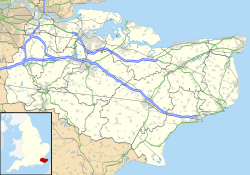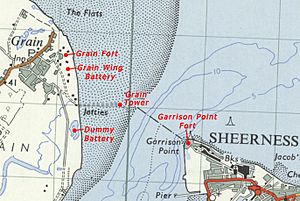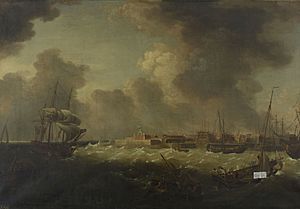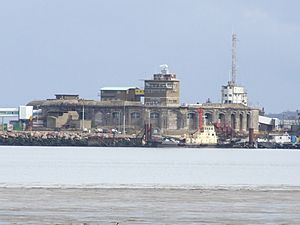Garrison Point Fort facts for kids
Quick facts for kids Garrison Point Fort |
|
|---|---|
| Sheerness, Kent, England | |
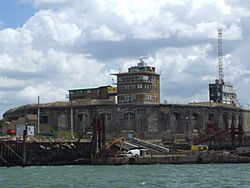
Garrison Point Fort viewed from the Medway
|
|
| Coordinates | 51°26′49″N 0°44′40″E / 51.4469°N 0.74441°E |
| Type | Fortification |
| Site information | |
| Owner | Medway Ports Ltd |
| Condition | Intact |
| Site history | |
| Built | 1861–72 |
| Built by | United Kingdom |
| In use | 1872–1956 |
| Materials | Concrete, granite, brick |
Garrison Point Fort is an old fort located at the end of the Garrison Point area in Sheerness, Kent. It was built in the 1860s. This fort was made to protect Britain from a possible French invasion.
It was the last of many gun batteries that had been on this spot since the mid-1500s. The fort's location was very important. It guarded where the River Medway meets the River Thames. It is special because it has two levels of gun rooms, called casemates. This design was rare for its time. The fort was used until 1956 and is now part of the Sheerness Docks.
Contents
Why Was Garrison Point Fort Built?
Garrison Point Fort was built because Britain and France were building more warships. Britain's old coastal defenses were not strong enough. New, powerful guns on fast, armored ships made the old forts useless. The River Thames was a very important area. It was a major trade route. It also had important naval bases and weapons factories.
To deal with this threat, the government set up a special group. This group was called the Royal Commission on the Defence of the United Kingdom. In 1860, they suggested many changes. They said that many old forts needed to be updated or rebuilt. New forts were also needed at important places. About 70 new forts and batteries were built around England because of this report.
Garrison Point had been a fortified spot for a long time. A square blockhouse was built there by 1547. This was during the time of Henry VIII. A new fort was being built when it was destroyed in 1667. This happened during the Raid on the Medway in the Second Anglo-Dutch War.
It was rebuilt by 1669. This new fort was designed by Bernard de Gomme. He also designed Tilbury Fort. The Royal Commission said these old forts were too weak. They needed to be replaced by a strong, armored fort. This new fort would work with Grain Fort and Grain Tower across the Medway.
How Was Garrison Point Fort Built?
Building the fort started in February 1861. It finished in June 1872. By then, about half of its guns were already in place. The new fort was shaped like a half-circle. It was one of only two forts built this way in the 1860s. The other was Picklecombe Fort in Cornwall.
The fort had two levels for guns. Each level had 17 gun rooms, called casemates. These rooms had granite fronts. They held 36 heavy guns behind thick iron shields. Two more gun towers were planned for the roof but were never built. The ammunition rooms, called magazines, were underground.
Most of the fort was built with brick. Concrete was added later. The walls were very thick, about 4.4 meters (14.4 feet). The half-circle of casemates was closed off at the back. This part had strong buildings made of stone. They had small openings for defense. A parade ground was in the middle of the fort.
What Was the Fort Used For?
Garrison Point Fort first had large guns. These were 9-inch and 10-inch rifled muzzle loader (RML) guns. By 1880, it had even bigger guns. These included 11-inch and 12.5-inch RMLs. In 1884, a Brennan torpedo station was added. This was used to launch wire-guided torpedoes. It was used until about 1906.
The RML guns became old-fashioned by the late 1800s. They were removed by 1896. The casemates were then used as barracks for soldiers and for storage. In 1909, two 6-inch guns were put on the fort's roof. Four 12-pounder quick-firing guns were placed in the lower casemates.
During the First World War, a searchlight and a concrete magazine were built near the fort. A machine-gun pillbox was also built, but it is gone now. Garrison Point Fort was still used during the Second World War. It got new guns to defend against fast enemy boats. These were twin 6-pounder guns. One was on the roof, and one was outside the casemates. New gun positions, towers, a magazine, and a searchlight were also built. By 1944, the threat of attack lessened. The fort was then put on standby.
After the war, the fort had a new role. The Royal Navy Auxiliary Service used it. It became an emergency control center in case of a nuclear war. Part of the old magazine was turned into a bunker. This bunker would house nuclear defense officials. The fort was officially closed in 1956. This happened when the UK stopped its coastal defense program. The fort was then sold to the owners of the nearby Sheerness Docks.
What Is Garrison Point Fort Like Today?
Garrison Point Fort has been a Grade II listed building since 1977. This means it is an important historic site. It is also part of the Sheerness defenses, which are a scheduled monument. The fort is owned by Medway Ports Ltd. They run the Sheerness Docks. Because it is inside the port area, people cannot visit it.
Some changes have been made to the fort for port use. In the 1980s, it was used as a terminal for a ferry service to Europe. A walkway was added through one of the casemates for this. In 1962, a radar control tower was put on the fort's roof. This tower helps guide ships.
Garrison Point Fort is slowly decaying. It is on the Heritage at Risk Register. This list shows historic places that need care. The inside of the fort has been mostly emptied. But some original parts can still be seen. A lot of the Brennan Torpedo station and its rails are still there. However, they are rusting badly. The fort's main structure is still strong. But its roof and much of its inside are old and falling apart.


